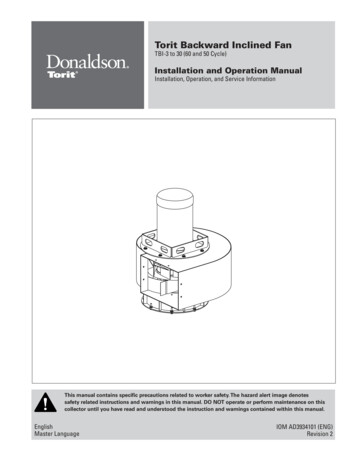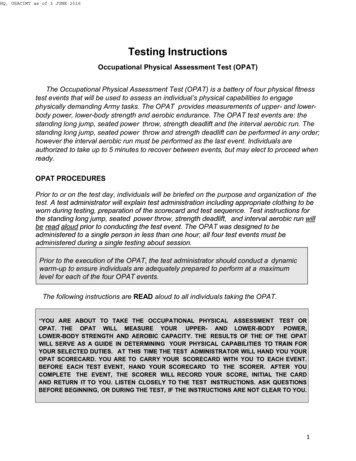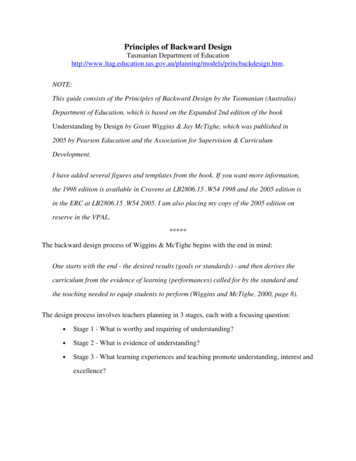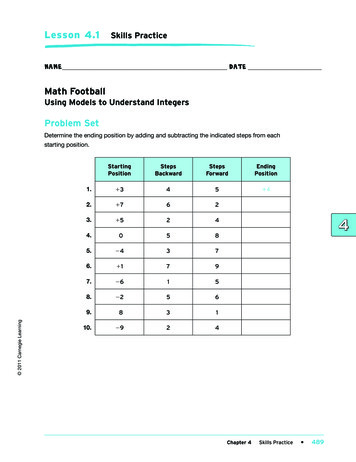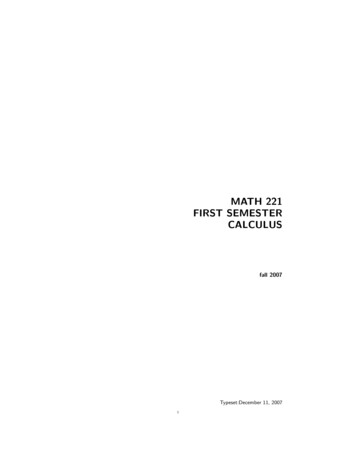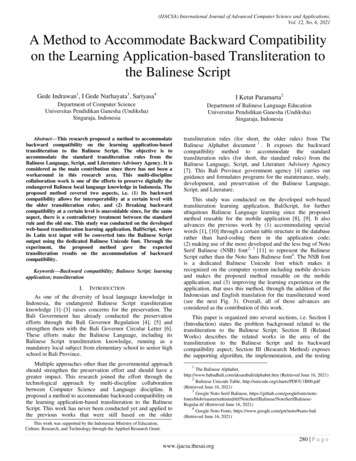
Transcription
(IJACSA) International Journal of Advanced Computer Science and Applications,Vol. 12, No. 6, 2021A Method to Accommodate Backward Compatibilityon the Learning Application-based Transliteration tothe Balinese ScriptGede Indrawan1, I Gede Nurhayata3, Sariyasa4I Ketut Paramarta2Department of Computer ScienceUniversitas Pendidikan Ganesha (Undiksha)Singaraja, IndonesiaDepartment of Balinese Language EducationUniversitas Pendidikan Ganesha (Undiksha)Singaraja, IndonesiaAbstract—This research proposed a method to accommodatebackward compatibility on the learning application-basedtransliteration to the Balinese Script. The objective is toaccommodate the standard transliteration rules from theBalinese Language, Script, and Literature Advisory Agency. It isconsidered as the main contribution since there has not been aworkaround in this research area. This multi-disciplinecollaboration work is one of the efforts to preserve digitally theendangered Balinese local language knowledge in Indonesia. Theproposed method covered two aspects, i.e. (1) Its backwardcompatibility allows for interoperability at a certain level withthe older transliteration rules; and (2) Breaking backwardcompatibility at a certain level is unavoidable since, for the sameaspect, there is a contradictory treatment between the standardrule and the old one. This study was conducted on the developedweb-based transliteration learning application, BaliScript, whereits Latin text input will be converted into the Balinese Scriptoutput using the dedicated Balinese Unicode font. Through theexperiment, the proposed method gave the expectedtransliteration results on the accommodation of backwardcompatibility.Keywords—Backward compatibility; Balinese Script; learningapplication; transliterationI.INTRODUCTIONAs one of the diversity of local language knowledge inIndonesia, the endangered Balinese Script transliterationknowledge [1]–[3] raises concerns for the preservation. TheBali Government has already conducted the preservationefforts through the Bali Governor Regulation [4], [5] andstrengthen them with the Bali Governor Circular Letter [6].These efforts make the Balinese Language, including itsBalinese Script transliteration knowledge, running as amandatory local subject from elementary school to senior highschool in Bali Province.Multiple approaches other than the governmental approachshould strengthen the preservation effort and should have agreater impact. This research joined the effort through thetechnological approach by multi-discipline collaborationbetween Computer Science and Language discipline. Itproposed a method to accommodate backward compatibility onthe learning application-based transliteration to the BalineseScript. This work has never been conducted yet and applied tothe previous works that were still based on the oldertransliteration rules (for short, the older rules) from TheBalinese Alphabet document 1 . It exposes the backwardcompatibility method to accommodate the standardtransliteration rules (for short, the standard rules) from theBalinese Language, Script, and Literature Advisory Agency[7]. This Bali Province government agency [4] carries outguidance and formulates programs for the maintenance, study,development, and preservation of the Balinese Language,Script, and Literature.This study was conducted on the developed web-basedtransliteration learning application, BaliScript, for furtherubiquitous Balinese Language learning since the proposedmethod reusable for the mobile application [8], [9]. It alsoadvances the previous work by (1) accommodating specialwords [1], [10] through a certain table structure in the databaserather than hard-coding them in the application code;(2) making use of the more developed and the less bug of NotoSerif Balinese (NSB) font 2 , 3 [11] to represent the BalineseScript rather than the Noto Sans Balinese font4. The NSB fontis a dedicated Balinese Unicode font which makes itrecognized on the computer system including mobile devicesand makes the proposed method reusable on the mobileapplication; and (3) improving the learning experience on theapplication, that uses this method, through the addition of theIndonesian and English translation for the transliterated word(see the next Fig. 3). Overall, all of those advances areconsidered as the contribution of this work.This paper is organized into several sections, i.e. Section I(Introduction) states the problem background related to thetransliteration to the Balinese Script; Section II (RelatedWorks) describes the related works in the area of thetransliteration to the Balinese Script and its backwardcompatibility aspect; Section III (Research Method) exposesthe supporting algorithm, the implementation, and the testing1The Balinese bet.htm (Retrieved June 16, 2021)2Balinese Unicode Table, http://unicode.org/charts/PDF/U1B00.pdf(Retrieved June 16, 2021)3Google Noto Serif Balinese, eRegular.ttf (Retrieved June 16, 2021)4Google Noto Fonts, ed June 16, 2021)This work was supported by the Indonesian Ministry of Education,Culture, Research, and Technology through the Applied Research Grant.280 P a g ewww.ijacsa.thesai.org
(IJACSA) International Journal of Advanced Computer Science and Applications,Vol. 12, No. 6, 2021of the proposed method; Section IV (Result and Analysis)covers the analysis of the testing result; and finally, Section V(Conclusion) consists of important conclusion and future workpoints.II. RELATED WORKSSeveral related works on Latin-to-Balinese Scripttransliteration were conducted on the previous works [10],[12]–[20]. All of those were still based on the older rules fromThe Balinese Alphabet document, except [20]. DisplayingBalinese Script output on those previous research was done bynon-dedicated Balinese Unicode fonts (i.e. Bali Simbar 5 andBali Simbar Dwijendra [21]) and dedicated Balinese Unicodefont2 [11] (i.e. Noto Sans Balinese and Noto Serif Balinese).The Bali Simbar (BS) font was utilized in [12] and gave arelatively good accuracy result on testing cases from TheBalinese Alphabet document. It was also utilized in thedeveloped robotic system that writes the Balinese Script fromthe Latin text input [13], and on the exploration of the linebreak handling during the transliteration [14]. The Bali SimbarDwijendra (BSD) font, as the improvement of the BS font, wasutilized in [15] with additional testing cases from the BalineseScript dictionary [7] to the same testing cases on [12]. It wasalso utilized in the exploration of the mathematical expressiontransliteration [16]. Ten transliteration lessons were alsolearned by using this font on the other testing data [17]. TheNoto Sans Balinese font was utilized in [10] with the sametesting cases in [12] and gave a relatively good accuracy result.It was also utilized in the developed robotic system that writesBalinese Script from the Latin text input [18]. Extensiveaccuracy analysis on the developed algorithm [10] was done in[19] for future improvement. the Noto Serif Balinese font wasutilized in [20] for the unavoidable affixed words that need tobe transliterated.same aspect, there is a contradictory treatment between thestandard rule and the old one.This section describes (1) the supporting algorithm of theproposed method; (2) the implementation on the BaliScript,which is the web-based transliteration learning application; and(3) the testing by using the updated testing cases of TheBalinese Alphabet document to comply with the standardtransliteration rules from the Balinese Language, Script, andLiterature Advisory Agency [4], [7].A. The AlgorithmThe proposed method involves the NSB font with itsdedicated Balinese Unicode Table [20]. The algorithm toaccommodate backward compatibility on the transliteration tothe Balinese Script covers two aspects, as described previously.The first aspect involves transliteration of the letter set MBC(Maintaining Backward Compatibility), i.e. the vowel “ě”(U 011B) with sound [ə] [24], “ö” (U 00F6) with the longsound of the vowel “ě”, the consonant na rambat “ņ” (U 0146)with sound [ɳa], sa sapa “ś” (U 015B) with sound [ʂa], sa saga“ş” (U 015F) with sound [ɕa], ta latik “ŝ” (U 0163) withsound [ʈa], or its uppercase letter “Ě” (U 011A), “Ö” (U 00D6), the consonant “Ņ” (U 0145), “Ś” (U 015A), “Ş”(U 015E), “Ŝ” (U 0162). The second aspect involvestransliteration of the letter set BBC (Breaking BackwardCompatibility), i.e. the vowel “e” (U 0065) or its uppercaseletter “E” (U 0045) that has sound [e]. Noted that theuppercase letters were not the concern, since each of them hasthe same transliteration result as its counterpart lowercaseletter.Those two aspects should be handled by the proposedmethod. Fig. 1 shows the flowchart of the algorithm and usesregular expression [25], [26] on the implementation.startThe other side of transliteration related to the BalineseScript-to-Latin transliteration that utilized the GNU OpticalCharacter Recognition (OCR), i.e. Ocrad6 [22]. This researchwas limited only to the basic syllable recognition (see TheBalinese Alphabet document) from the Balinese Script imagethat was based on the glyph shape of the Bali Simbar font. Foradvancing functionality and mobile adoption for ubiquitouslearning, the utilization of the Tesseract7 OCR was conductedthat needs several future improvements [23].letter set MBC { “ě ö ņ ś şĚ Ö Ņ Ś Şletter set BBC { “e ENoletterIII. RESEARCH METHODThe proposed method to accommodate backwardcompatibility on the transliteration to the Balinese Scriptcovers two aspects related to the older transliteration rules fromThe Balinese Alphabet document. Those two aspects, i.e.(1) Backward compatibility allows for interoperability at acertain level with the older rules; and (2) Breaking backwardcompatibility at a certain level is unavoidable since, for ntainsbackwardcompatibilityŝŜBBCno backwardcompatibilityissueendFig. 1. The Flowchart of the Algorithm.5Bali Simbar, (Retrieved June 16, 2021)6The GNU Ocrad OCR, https://www.gnu.org/software/ocrad/ (RetrievedJune 16, 2021)7Tesseract OCR, https://github.com/tesseract-ocr/ (Retrieved June 16,2021)281 P a g ewww.ijacsa.thesai.org
(IJACSA) International Journal of Advanced Computer Science and Applications,Vol. 12, No. 6, 2021B. The ImplementationFig. 2 (a) shows the Model-View-Controller (MVC)architecture [27]–[29] of the web-based transliteration learningapplication, BaliScript, that was used by the proposed method.The supporting database’s table (Fig. 2 b) consists of recordsfrom the Balinese Script dictionary [7]. Fig. 3 shows theIndonesian and English translation of the exampletransliterated word for improving the learning experience onthe application. As described previously, this feature is one ofseveral advances as the contribution of this work. TheBaliScript was constructed by Apache web server, MySQLdatabase server, and PHP code combined with JavaScript code.This application was also used for the exploration of scriptiocontinua management in the previous work [30].Fig. 3 (a) shows the View of the MVC, i.e. (1) the inputview that uses the Select box 8 ; and (2) output view thatdisplays the transliteration result and other results from theclosest similar words in the database where the similaritycalculation is based on the Levenshtein distance [31], [32]. Fig.3 (b) shows the transliteration output from the examplehomonym word [33], [34] at the similarity list by using AJAXbased switching (clicking on the word “USE” related to thecertain word).(a)C. The TestingThe testing of the proposed method was conducted on theBaliScript, which was run on the Intel Core i7-4600U CPU@2.09GHz platform with 8 GB RAM and Windows 8 64-bitOperating System.(b)(a)Fig. 3. The View of the BaliScript with Transliteration and TranslationResult at the Same Time: (a) Output with the Closest Similar Words; (b)Output from the Example Homonym Word at the Similarity List.IV. RESULT AND ANALYSIS(b)Fig. 2. The BaliScript Implementation: (a) MVC Architecture; (b)Supporting Table in the Database8Table I shows the testing cases consist of sections ofinterest (the marked sections) related to the result of backwardcompatibility (see Fig. 4). Noted that the testing used theupdated testing cases that comply with the standardtransliteration rules from the Balinese Language, Script, andLiterature Advisory Agency [7] rather than the original testingcases [10] that refer to The Balinese Alphabet document.Select2 box, https://select2.org (Retrieved June 16, 2021)282 P a g ewww.ijacsa.thesai.org
(IJACSA) International Journal of Advanced Computer Science and Applications,Vol. 12, No. 6, 2021TABLE I.TESTING TRANSLITERATION CASESNo.CaseaCasebRemarksc1ha na ca ra ka da ta sa wa la ma ga ba nga pa ja yanyaBakta Kala Paksa Raka Cakra Walaka Kramaha na ca ra ka da ta sa wa la ma ga ba nga pa ja yanyaBakta Kala Paksa Raka Cakra Walaka Krama2Kādep Jěro Siya Kayu Sela Angklung DaityaPatūt DwīKādep Jěro Siya Kayu Sēla Angklung DaityaPatūt Dwī3a ā i ī u ū e ai o auAkśara Işwara Upacāra Eka Airlangga Ong OMa ā i ī u ū ē ai o auAkśara Işwara Upacāra Eka Airlangga Ong OM4rě rö lě löTalěr Kěrěngrě rö lě löTalěr KěrěngBasic syllables and examples.Bring Time Force “Bigger brother” Disc “A nonpriest” MemberVowel signs examples.Sold House Nine Wood Yam “Musicalinstrument” Giant “Should be” TwoIndependent vowels and examples.Alphabet “God’s name” Ceremony One “AJavanese King” “One holy letter” “Symbol ofGod”Illegal combination of syllable - vowel signs andexamples.Also “Eat a lot”Semi vowels examples.Mr. Raman Membership Stupid “Naive Rubag”Laughter5Pak Raman Pakraman Baglug Rubag lugu BriagPak Raman Pakraman Baglug Rubag lugu Briag6ņa dha tha ţa şa śa gha bha phaGaņitri Garudha Partha Jaţayu Bhiśama ŞiwaLaghuņa dha tha ţa şa śa gha bha phaGaņitri Garudha Partha Jaţayu Bhiśama ŞiwaLaghu7Cengceng Bangkung Manah Karņa KapalCēngcēng Bangkung Manah Karņa KapalSound killers examples.“Musical instrument” Pig Mind Ear Ship8Mang SiddhamMang SiddhamMiscellaneous signs examples.“Holy letter” Perfect9Om Swastiastu Om Şanti, Şanti, Şanti, OmOm Swastiastu Om Şanti, Şanti, Şanti, OmHoly symbol Ongkara examples.“May God blesses you” “May peace beeverywhere”10cha khacha khaMiscellaneous syllables.1101234567890123456789The digits.12, . .0. : ", . .0. : "Punctuations.iueoěöiuēoěöpu phuSekala sekalěpu phuSekala sekalěSamping Sukśma Kśatria Strī Smerti UtamaDharma TamblangSamping Sukśma Kśatria Strī Smerti UtamaDharma TamblangSome variation of usages.Combination of independence vowel a kara withvowel signsPairing of pa kapal with suku or suku ilutRomanization of the inherent sound: Real realUsage of pangangge akśara:Side “Thank you” Warrior Wife “Books ofVedha” Primary Religion “A village’s name”14hā nā cā rā kā dā tā sā wā lā mā gā pā yā ņā dhāthā ţā şā śā ghā bhāhā nā cā rā kā dā tā sā wā lā mā gā pā yā ņā dhāthā ţā şā śā ghā bhāLigatures.15Bank Pembangunan Daerah BaliBe Pe De BaliBa Pe Da BaliBa Pa Da BaliBank Pembangunan Daerah BaliBē, Pē, Dē, BaliBa, Pe, Da, BaliBa, Pa, Da, BaliAbbreviations examples.Regional Development BankBali Be Pe DeBali Ba Pe Da BaliBa Pa Da Bali16Akeh akśarane, 47, luir ipun: akśara suara, 14,akśara wianjana, 33, akśara suara punika talěrdados pangangge suara, tur madrěwe suarakakalih, kawāśţanin: suara hrěswa miwah dīrgha.Akeh akśaranē, 47, luir ipun: akśara suara, 14,akśara wianjana, 33, akśara suara punika talěrdados pangangge suara, tur madrěwe suarakakalih, kawāśţanin: suara hrěswa miwah dīrgha.Word boundaries and line break rules.Many of those letters, 47, i.e.: vowels, 14,consonants, 33, those vowels also become vowelsigns, and have two sounds, each is called: soundhrěswa and dīrgha.Akśara swalalita and examples.13Chain “Big eagle” “Arjuna's alias” “A bird inRamayana” Decree “God’s name” “Low tone insinging”a.b.The original testing casesThe updated testing cases that comply with the standard transliteration rulesc.The Balinese Alphabet document283 P a g ewww.ijacsa.thesai.org
(IJACSA) International Journal of Advanced Computer Science and Applications,Vol. 12, No. 6, 2021For example in case 2 of Table I, since the vowel “e” of theBalinese word “Sēla” (Yam) has sound [e] [24] for a certainmeaning (the other “e”, U 0065, with sound [ə] has a differentmeaning), to comply with the standard rule, the writing of thatvowel should be changed to “ē”. This condition breaksbackward compatibility of the transliteration since the vowel“e” is a member of the letter set BBC (see The Algorithmsection).There are several sections of interest in Table I related tothe testing result, i.e.: The bold underlined section on the original testing caseshows a section of interest related to the backwardcompatibility of the transliteration. The bold underlined section on the updated testing caseshows a section of interest that has backwardcompatibility where its transliteration result adheres to[7] and is the same as the transliteration result of theoriginal testing case. This backward compatibility wasachieved due to the process related to the algorithm. The bold dotted-underlined section on the updatedtesting case shows a section of interest that has atransliteration result that adheres to [7] but differentfrom the transliteration result of the original testingcase using The Balinese Alphabet document. The bold gray section on the updated testing case showsa section of interest that has broken backwardcompatibility by using different writing where itstransliteration result adheres to [7] and the same to thetransliteration result of the original testing case. The underline-across-space section on the updatedtesting case shows a section of interest that has atransliteration result that adheres to [7] and differentfrom the transliteration result of the original testingcase. This is because continuous (phrase or sentence)transliteration was used rather than word-by-wordtransliteration. If both updated and original testing casesuse the same kind of transliteration then the resultshould be the same. It needs to be mentioned as aperspective that relatively was not related to backwardcompatibility. For example in case 2 of Table 2, theBalinese phrase “Kādep Jěro” (Sold House) hascontinuous transliteration result “ᬓᬵᬤᭂᬧ᭄ᬚᭂᬭᭀ”word “Kādep”) while its vowel “ě” was transliterated asa vowel sign (upper form).Even though Balinese Script employs scriptio continuastyle [35], Fig. 4 shows its transliteration result in non-scriptiocontinua style (including preserved line breaks) which ispossible to be generated for ease of visual analysis by theBaliScript learning application. This style was supported by thewhite-space 9 property of Cascading Style Sheets (CSS) thatwas set as pre-line. This kind of non-scriptio continua style hasthe same space and line break format as its Latin text inputfrom the testing transliteration cases of Table I. It has a clearmapping between the input section of the Latin text (i.e.alphabet, syllable, word, or punctuation) and its related outputsection of the Balinese Script. That clear mapping was causedby the spaces and line breaks between those sections that werepreserved by the transliteration algorithm [30].adheres to [7] and different from word-by-wordtransliteration result “ᬓᬵᬤᭂᬧ᭄ ᬚᭂᬭᭀ”. In continuoustransliteration, the second word of “Jěro” (House) hasits consonant “J” was transliterated in appended form as“ᬧ᭄ᬚᭂ” (hanging below the regular form of consonant“p” of word “Kādep”) while its vowel “ě” wastransliterated as a vowel sign (upper form). In word-byword transliteration, the second word of “Jěro” has itsconsonant “J” was transliterated in regular form as “ᬚᭂ”(positioned on the side after the sound killer adeg-adeg“᭄” that kill the inherent sound of consonant “p” ofFig. 4. The Balinese Script Transliteration Result with non-scriptio ContinuaStyle, Including Preserved Line Breaks, from the BaliScript LearningApplication.9CSS white-space, https://www.w3schools.com/cssref/pr text whitespace.asp (Retrieved June 16, 2021)284 P a g ewww.ijacsa.thesai.org
(IJACSA) International Journal of Advanced Computer Science and Applications,Vol. 12, No. 6, 2021The backward compatibility analysis of the transliterationresults in Fig. 4 was based on the marked sections in Table I.The algorithm maintains backward compatibility and on theother side unavoidably breaks backward compatibility tocomply with the standard transliteration rules [7].Related to maintaining backward compatibility, the boldunderlined section on the updated testing case shows a sectionof interest where its transliteration result adheres to [7] and isthe same as the transliteration result of the original testing case.For example, in case 2 of Table I, the Balinese phrase “KādepJěro” (Sold House) has its continuous transliteration result“ᬓᬵᬤᭂᬧ᭄ᬚᭂᬭᭀ” that adheres to [7] and is the same as thecontinuous transliteration result from The Balinese Alphabetdocument (see the previous underline-across-space section).The bold underlined sections, i.e. the vowel “e” (U 0065)of the word “Kādep” and “ě” (U 011B) of the word “Jěro” hasthe same sound [ə] [24] and should be transliterated the sameby using “ᭂ” (Balinese vowel sign pepet, U 1B42). Theirvariant words from [7], i.e. “adep” (only available in its rootword) and “jero” should be transliterated the same. Thesevariances of words “Kādep”, “kadep”, “Jěro”, “jero”, andothers should be registered with their related same value incolumn “sword” of database’s table (see Fig. 2 b) for the sametransliteration result. This is the effort for maintainingtransliteration backward compatibility along with other cases inTable I, i.e. word “Akśara”, “Işwara”, “Gaņitri”, “Bhiśama”,“Şiwa”, “Karņa”, “Şanti”, “sekalě“, ”Sukśma”, “Kśatria”,“Pembangunan”, “Daerah”, “Akeh”, “talěr”, “pangangge“,”madrěwe“, ”kawāśţanin”, and “hrěswa”.From those cases with bold underline marks, certain ofthose were also marked with bold dotted-underline since eachof them has a transliteration result that adheres to [7] butdifferent from the transliteration result of the original testingcase. For example, the Balinese word “Işwara” (God’s name)and “Bhiśama” (Decree), each in case 3 and case 6 of Table I,have their variant words from [7], i.e. “Iswara” and “bisama”should be transliterated the same “ᬈᬰ᭄ᬯᬭ” and “ᬪᬷᬱᬫ”[7] but different from the transliteration result “ᬇᬰ᭄ᬯᬭ”(without vowel sign tedung “ᬵ”) and “ᬪᬶᬱᬫ” (without vowelsign ulu sari “ᬷ”). This is a condition that should be taken careof by the effort for maintaining backward compatibilitytransliteration. Above that condition, these variances of word“Işwara”, “Iswara”, “Bhiśama”, “bisama”, and others shouldbe registered with their related same value in column “sword”of database’s table (see Fig. 2 (b)) for the same transliterationresult that adheres to [7].From those cases with bold underline marks, certain ofthose were safe to associate its vowel “e” (U 0065) to thevowel “ē” (U 0113) through the database registration becauseof its sound [e] [24]. This condition was possible since nocounterpart word has the vowel “e” (U 0065) with sound [ə].This condition is related to the next testing cases with the boldgray section. For example, the Balinese word “Akeh” (Many),in case 16 of Table I, has its variant words from [7], i.e. “akēh”should be transliterated the same “ᬳᬓᬾᬄ” [7]. As theexception to the standard rule [7] where the vowel “e”(U 0065) should be transliterated by using “ᭂ” (Balinese vowelsign pepet, U 1B42) while the vowel “ē” (U 0113) should betransliterated by using “᭄” (Balinese adeg-adeg, U 1B44),these variances of the word “Akeh”, and “akēh” should beregistered with their related same value in column “sword” ofdatabase’s table (see Fig. 2(b)) for the same transliterationresult that adheres to [7]. This is a condition that should betaken care of by the effort for maintaining backwardcompatibility transliteration since by nature people write theword in the easiest way (write “e” rather than “ē”), includinginputting text to the transliteration application.Related to unavoidable breaking backward compatibility tocomply with the standard transliteration rules [7], the bold graysection on the updated testing cases shows a section of interestthat has broken backward compatibility by using differentwriting where its transliteration result adheres to [7] and thesame to the transliteration result of the original testing case.For example, in case 2 of Table I, the Balinese word “Sēla”(Yam) with its vowel “ē” (U 0113) has its transliteration result“ᬲᬾᬮ” that adheres to [7] and is the same as thetransliteration result from The Balinese Alphabet document(see the previous standard rules [7] where the vowel “e” and“ē”, each should be transliterated by using vowel sign pepetand sound killer adeg-adeg). If using the Balinese word “Sela”with its vowel “e” (U 0065) from the original testing case, itstransliteration result “ᬲᭂᬮ” does not adhere to [7] even thoughis the same as the transliteration result from The BalineseAlphabet document.V. CONCLUSION AND FUTURE WORKA method to accommodate backward compatibility wasproposed on the learning application-based transliteration tothe Balinese Script. It covered two aspects related toconsidered sets of letters. The first aspect concerns thetransliteration of a certain set of letters that causes backwardcompatibility to be maintained. The second aspect concerns thetransliteration of a certain set of letters that causes backwardcompatibility to be broken unavoidably to comply with thestandard rules from the Balinese Language, Script, andLiterature Advisory Agency.ACKNOWLEDGMENTThis work was supported by the Indonesian Ministry ofEducation, Culture, Research, and Technology through themulti-years Applied Research Grant.[1][2][3]REFERENCESG. Indrawan, I. K. Paramarta, K. Agustini, and Sariyasa, “Latin-toBalinese script transliteration method on mobile application: acomparison,” Indones. J. Electr. Eng. Comput. Sci., vol. 10, no. 3, pp.1331-1342, Jun. 2018.S. Karimi, F. Scholer, and A. Turpin, “Machine transliteration survey,”ACM Comput. Surv., vol. 43, no. 3, pp. 1–46, Apr. 2011.K. Kaur and P. Singh, “Review of machine transliteration techniques,”Int. J. Comput. Appl., vol. 107, no. 20, pp. 13–16, 2014.285 P a g ewww.ijacsa.thesai.org
(IJACSA) International Journal of Advanced Computer Science and Applications,Vol. 12, No. 6, [17]Bali Government, “Bali Government Regulation No. 3 on BalineseLanguage, Script, and Literature [Peraturan Pemerintah Bali No. ://bphn.go.id/data/documents/perda 3 1992.pdf (Retrieved June 16,2021).Bali Government, “Bali Governor Regulation No. 80 on Protection andUsage of Balinese Language, Script, and Literature, also OrganizingBalinese Language Month [Peraturan Gubernur Bali No. 80 tentangPelindungan dan Penggunaan Bahasa, Aksara, dan Sastra Bali rak/24665(Retrieved June 16, 2021).Bali Government, “Bali Governor Circular Letter No. 3172 Year 2019about The Usage of Balinese Traditional Clothing and Balinese Script[Surat Edaran Gubernur Bali No. 3172 Tahun 2019 tentang strak/24741(Retrieved June 16, 2021).I. G. K. Anom et al., Balinese - Indonesian Dictionary with its Latin andBalinese Script [Kamus Bali - Indonesia Beraksara Latin dan Bali].Denpasar: Bali Province, 2009.G. J. Hwang, C. C. Tsai, and S. J. H. Yang, “Criteria, strategies andresearch issues of context-aware ubiquitous learning,” J. Educ. Technol.Soc., vol. 11, no. 2, 2008.H. Ogata, Y. Matsuka, M. M. El Bishouty, and Y. Yano, “LORAMS:linking physical objects and videos for capturing and sharing learningexperiences towards ubiquitous learning,” Int. J. Mob. Learn. Organ., vol.3, no. 4, pp. 337, 2009.G. Indrawan, I. K. Paramarta, and K. Agustini, “A new method of Latinto-Balinese script transliteration based on noto sans balinese font anddictionary data structure,” in The 2nd International Conference onSoftware Engineering and Information Management (ICSIM), 2019.The Unicode Consortium, The Unicode Standard Version 13.0 – CoreSpecification. The Unicode Consortium, 2020.G. Indrawan, Sariyasa, and I. K. Paramarta, “A new method of Latin-toBalinese script transliteration based on bali simbar font,” in The 4thInternational Conference on Informatics and Computing (ICIC), 2019.P. N. Crisnapati et al., “Pasang aksara bot: a Balinese script writing robotusing finite state automata transliteration method,” J. Phys. Conf. Ser.,vol. 1175, no. 1, pp. 012108, 2019.G. Indrawan, K. Setemen, W. Sutaya, and I. K. Paramarta, “Handling ofline breaking on Latin-to-Balinese script transliteration web applicationas part of Balinese language ubiquitous learning,” in The 6th InternationalConference on Science in Information Technology (ICSITech), 2020.G. Indrawan, I. P. E. Swastika, Sariyasa, and I. K. Paramarta, “Animproved algorithm and accuracy analysis testing cases of Latin-toBalinese script transliteration method based on bali simbar dwijendrafont,” Test Eng. Manag., vol. 83, pp. 7676–7683, 2020.G. Indrawan, G. R. Dantes, K. Y. E. Aryanto, and I. K. Paramarta,“Handling of mathematical expression on Latin-to-Balinese scripttransliteration method on mobile computing,” in The 5th InternationalConference on Informatics and Computing (ICIC), 2020.G. Indrawan, I. G. A. Gunadi, M. S. Gitakarma, and I. K. Paramarta,“Latin to Balinese script transliteration: lessons learned from computerbased implementation,” in The 4th Intern
transliterated word for improving the learning experience on the application. As described previously, this feature is one of several advances as the contribution of this work. The BaliScript was constructed by Apache web server, MySQL database server, and PHP code combined with JavaScript code.



